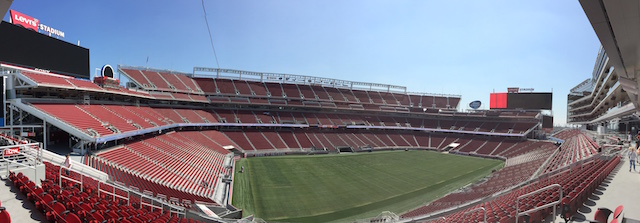23 August 2015 | Articles, Articles 2015, Marketing | By Christophe Lachnitt
Sports Stadiums And Arenas Go Digital
It’s all about experiential marketing.
The Internet has killed information scarcity. The typical social media user consumes 285 pieces of content daily, which equates to 54,000 words and 443 minutes of video (LifeHack, 2013). This excess of information leads to attention scarcity. When people are overwhelmed with the volume of information confronting them, they have difficulty discerning what to focus on. Attention rather than information becomes the scarce resource.
As a result, the challenge is to create memorable experiences that deeply engage people with brands’ content. Experiences are the new scarcity because they capture attention and create engagement in an information overload era where all links posted on the web are equal.
This is why experiential marketing flourishes – from street marketing to retail strategy. Experiential marketing – messaging one can touch, feel or view in a physical space – is on the rise. Rather than looking at consumers as passive receivers of messages, experiential marketing encourages participation from the consumer as they are now used to doing on social networks. Experiential marketing can even create the “wow” factor that motivates people to share their brand experiences on the social web.
The value of experiences can be observed in art (museums are shifting from storehouse to attractions), music (concerts are one of the few consistently growing, non-digital segments of the industry), and sports (professional teams are enhancing their fans’ experience in stadiums and arenas) industries. In all sectors, the name of the game is to create experiences that can’t be matched online and to use digital technologies to cultivate conversations with one’s audiences.

Levi’s Stadium – (CC) Christophe Lachnitt
A research conducted by Mobile Sports Report (MSR) and Sports & Entertainment Alliance in Technology (SEAT) shows the extent to which American professional sports stadiums and arenas are going digital: Nearly eight in 10 are equipped with a distributed antenna system (DAS) and about two-thirds have high-quality WiFi in all seating areas. Also, 75.6% have their own game-day app.
A perfect example of this trend is Levi’s Stadium, home of the San Francisco 49ers. It is located in Santa Clara, in the heart of Silicon Valley, which explains why it is at the forefront of digital technology.
Through the Levi’s Stadium mobile app, spectators can order and pay for food and drinks in two ways – express pick-up or in-seat delivery ($5 additional charge). The app also provides instant replays of all the action and step-by-step directions to restrooms with the shortest lines.
Levi’s Stadium, which was built under budget ($1.2bn vs. $1.3bn) and completed more than a year ahead of schedule (it opened in July 2014), also offers the fastest WiFi in the NFL: There is one WiFi access point for each 60 seats. During the next Super Bowl, to be held in Santa Clara in 2016, the 70,000 spectators will be able to simultaneously stream an HD movie!


